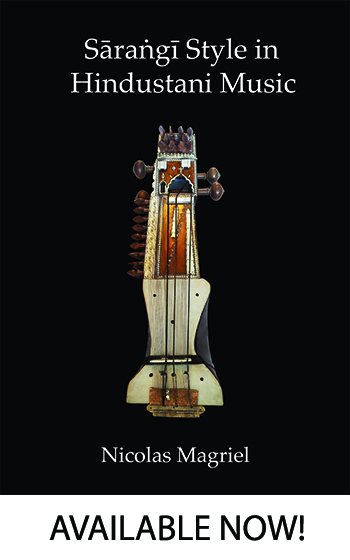Beyond Text: Growing into Music was a project hosted by SOAS, University of London between 2009 and 2012. We studied music transmission and childhood music acquisition in Cuba, Venezuela, Mali, Senegal, Azerbaijan and India. It was a longitudinal study—where possible, we observed the same children "growing into music" over three years, documented mainly through the medium of video. I was reponsible for research and filming of Indian classical musicians, Sufu Qawwali musicians and Rajasthani Langa and Manganyar folk musicians. I also did some filming in Azerbaijan. I published seven films which are presented below, but first I want to share four shorter "work-in-progress" films that were completed earlier in the project. These films have somewhat different focul points, but there is some overlap in the material presented. All films © Nicolas Magriel
Introductory Films
1) Growing into Music in Hindustan, Rajasthan, and Azerbaijan (14 minutes)
This film surveys the diverse modes of music transmission in these three musical cultures.
2) Growing into North Indian Art Music in Delhi, Banaras and Bhopal (32 minutes)
This film surveys some of the families of Indian classical musicians that I worked with in these three cities.
3) Growing into Music in Hamira, Rajasthan (26 minutes)
Here we have an introduction to the rich musical culture of the Manganiyar families in the village of Hamira in Western Rajasthan. Manganiyar Childhood below, a film of more than two hours, looks at many aspects of this culture in detail.
4) Observing Children's Musical Progress in Hindustani and Manganiyar Families (32 minutes)
This film highlights the longitudinal aspect of the study, focusing on a few children's musical growth.
Published Films
The following seven films were researched, filmed and edited by Nicolas Magriel. They comprise the Growing into Music in North India series. All films ©Nicolas Magriel and SOAS, University of London 2012 and 2013. For further background see www.growingintomusic.co.uk.
1) Talim aur Riyaz (Instruction and Practice): Pundalik Bhagwat and his Sons 2009, 2010, 2011 (70 minutes)
2) Talim aur Riyaz (Instruction and Practice): Ravi Shankar Mishra and his Sons 2009, 2010, 2011 (66 minutes)
3) Sangeet ka Khel (Music as Play): Sarwar Hussain and his sons 2009, 2010, 2011 (57 minutes)
4) Dukh ki Talim (Transmission in the Wake of Suffering): Vidya Sahai Mishra and his Grandsons 2010 and 2011 (33 minutes)
5) The Guru-shishya Parampara: Kanhaiyalal Mishra and his Students (33 minutes)
6) Dekhiye, Sikhiye, Parakhiye (Watch, Learn and Understand), Islamic mysticism and musical enculturation (45 minutes)
Most of the songs in this film are devotional—praising great Sufi saints such as Moinuddin Chisti (1141-1236 ce), Lal Shabhaz Qalandar (1177-1274 ce), Nizamuddin Aulia (1238-1325 ce) and Amir Khusro (1253-1325 ce). In their day-to-day discourse the Nizamis identify deeply with this tradition. Their practice room is suffused with history and faith.
The film depicts Ghulam Sabir and Mohammed Akbar Nizami teaching several boys of the family interspersed with interview footage of the two brothers which gives an intense glimpse of how their Sufi faith and a sense of musical and spiritual history inform their life and music.
7) Manganiyar Childhood (140 minutes)
This 140-minute film offers a rare opportunity for immersion in the musical life of children in the Manganiyar community—for sharing in their own immersion in music. The film begins by portraying three 18-month-old toddlers' participation in community musical life. We then see a wide variety of peer-learning situations—children making music together as play and recreation. A chapter on Manganiyar girls follows. Then several chapters deal with individual instruments, especially the quintessential Manganiyar instrument, the bowed kamaicha. Next we get an intensive look at the jajmani (patronage) system-we see children, following literally in their elders' footsteps, visiting patrons' houses to perform at marriage ceremonies. Sections on genealogical recitation and on duha, the deep and emotive un-metred aspect of Manganiyar music, follow.
Manganiyar children absorb music mainly by osmosis, by being surrounded by music making from infancy. So a long chapter on adult interventions in the learning process comes later in the film, as do two chapters which address more modern and articulate modes of music transmission. The penultimate chapter is about schooling—examining the difficulties of reconciling modern education and city life with the Manganiyars' traditional artistic lifestyle. Finally a chapter on change surveys the uncertainty arising as Manganiyar ethos and music are threatened by the attractions of urban life and the gradual erosion of the jajmani system.
Filming took place during three stays in Rajasthan in 2009, 2010 and 2011, and the sections on peer learning, kamaicha, dholak (a double-headed barrel drum), and teaching are presented chronologically so as to highlight childrens' musical maturation. Unlike in the learning of Indian classical music, there are few specific markers of progress. Children learn music much as they learn language. No one applauds the learning of repertoire or the perfection of technique—these are seen as natural functions of growing up.
On the DVD of this film, an eighteen-chapter menu makes speciality interests instantly accessible. Please contact us if you would like a copy of this DVD.



